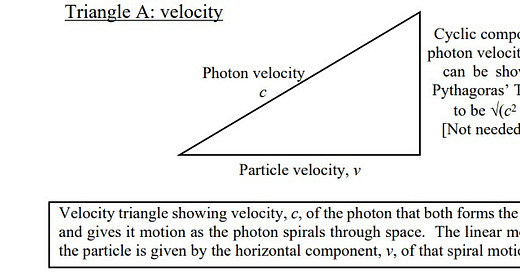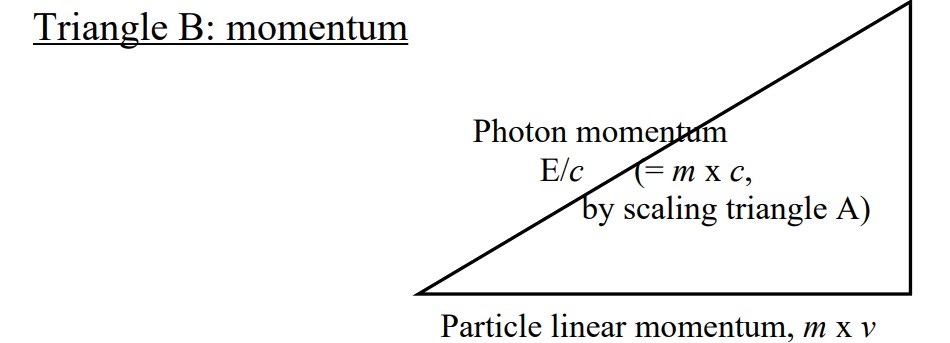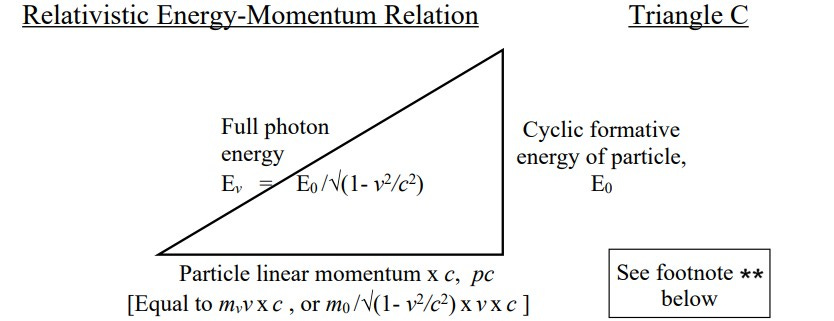[Posts are sequential, to be read/heard in date order - opposite to the order they’re generally displayed in. Paid-for posts have technical content.]
Please pass a link to these posts to any friend you feel may be interested.
To hear an audio version of this post (17 mins 51 secs), click the arrow below:
=====================
is without doubt the best known equation in the world. It’s generally regarded as indisputable proof of Einstein’s Theory of Special Relativity.
It might come as a bit of a surprise, then, to learn that it can be derived and proved with just a couple of simple diagrams, without any reference at all to the Principle of Relativity or indeed any maths other than one trivially simple multiplication.
We’ll use the discovery that particles of matter are formed from photons of light, which of course was an offshoot of Einstein’s discovery that all matter is energy. But we’ll derive that famous equation totally independently of Relativity Theory.
[Of course it’s easy to be clever with 20/20 hindsight, and this doesn’t in any way detract from Einstein’s genius in figuring out that relationship. But now we know more about the light-formed structure of particles we can fill in the practical down-to-earth details of why and how.]
First we’ll just remind ourselves of the two energy flow components, one that forms the particle itself and one that carries the particle along; they combine to give the spiral energy flow that is a particle moving through space. This is the fundamental principle of the spun-light understanding of matter that enables us to understand all of the apparent strangenesses attributed to Relativity.
As we saw in the previous post: What is Mass? What is Inertia?, we can show those components in the form of a right-angled triangle. The horizontal side is the particle speed through space, the vertical side is the speed around the particle-forming loop and the diagonal is the overall speed of the spiralling photon (or photons) combining particle formation and motion. The particle speed is v and the overall photon speed is c, the speed of light. [We won’t need the vertical side here.]
If it helps you can imagine straightening out that spiral to form a diagonal across the sky and also straightening out the particle-forming loop to make a vertical line down from the diagonal to join the horizontal line of the particle’s linear motion. That doesn’t change any of the speed components, and it may make it easier to understand what the sides of the triangle represent.
[For purists, we’ll consider this to be an instantaneous snapshot of velocity components; this deals with the steady change in direction of circling velocity and momentum vectors.]
We can draw another triangle to show the momentum of those various parts of the motion. In simple terms momentum might be described as the ‘strength of movement’ of something in motion, a quality that it can pass on to other objects: for example, a moving billiard ball has momentum and it can give momentum to another ball if it hits it.
In science and maths the momentum of an object is usually defined as its mass multiplied by its velocity (velocity is both speed and direction). In the 19th Century James Clerk Maxwell established that, even though it doesn’t have mass, a photon has momentum equal to its energy divided by the speed of light, E/c. Compton gave a practical demonstration of that half a century later by bouncing photons off electrons and showing how momentum was transferred from photons to electrons in the process (just like those billiard balls).
Obviously the momentum of any motion must be in the same direction as the motion itself, so our momentum triangle will be the same shape as our velocity triangle. The base line will be the momentum of the particle’s motion, m x v, and the diagonal will be the photon momentum E/c, where E is the spiralling photon energy that both forms the particle and gives it that motion.
In triangle B we see those momentum quantities. Since triangle B is the same shape as triangle A (the mathematical term is similar) the proportions of each pair of corresponding sides are the same – triangle B is just a scaled version of triangle A.
We can see that the base of triangle B is m times the base of triangle A, so the diagonal side of triangle B must be m times the diagonal of triangle A, since all the sides must be scaled by the same factor if the two triangles are the same shape.
That’s it. That’s all there is to it. No metaphysics, no Relativity, no heavy maths, just spun-light commonsense.
Strictly speaking, of course, this equation is the wrong way round. The inertial mass of an object is the consequence of its formative energy, not vice versa. So the mass should be defined in terms of the energy content:
=================================
A few technical notes on this result
Some of you might be wondering how this all pans out if we approach it from a more conventional angle, involving definitions of energy transfers and a decent helping of differential calculus. That approach is laid out in detail in another post, to follow this one: The Maths of Mass-Energy Equivalence - a premium [paid-for] post.
=====================
Next up, we’ll look at the whole issue of gravitation: what it is, why it happens and how the spun-light understanding of material particles explains every aspect of this cosmic phenomenon.
In the meantime, be sure to check out Transfinite Mind for a wealth of free resources, including non-technical articles and presentations, as well as books to suit every level of scientific (or non-scientific) background.
Also, if you find these articles interesting and thought-provoking, and you know others who may find them of interest, please be sure to point those others in this direction. Thanks.
See you next time around!











